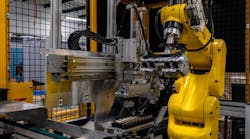Using the latest micro-focus x-ray fluorescence (XRF) technology, the self-contained LeadHound can detect the presence of lead, cadmium, mercury, chromium and bromine, as well as other elements, in a safe working environment and provide the percentage of each element found in a tested item. This enables shops to determine if an item complies with RoHS/WEEE directives or if soldering materials or components comply with military and avionics specifications.
"XRF is a proven non-invasive, non-destructive technique that is being adapted to the electronics industry and the manufacturing/repair environment," said Tim Hoffman, president, HEPCO. "LeadHound can test several items in one session and typically generate a report for most requirements in 30 seconds. It can take as little as 15 seconds. This is still a far cry from the several days required to send samples to laboratories for analysis. LeadHound generates a report after each test that can be printed or stored as a file to meet all applicable documentation needs. We will be able to add upgrades through software."
"Every facility should be performing some kind of incoming inspection," Hoffman continued. "Lead-free and leaded components need to be kept separate for compliance, and even in basic production needs, they have different temperature requirements for soldering. If a facility doesn’t take those into account, its customers and their end-users will have problems down the line."
In addition to testing boards and components, LeadHound also can detect lead in BGA spheres and solder paste in pots.
To operate LeadHound, users can place one or several items, depending on their size, on the LeadHound’s scanner bed, which is housed inside an x-ray chamber. An interlock enables the system once the door is fully closed.
Once the chamber is ready, the operator moves the item to be tested under the non-radioactive, low-power x-ray beam using a joystick and motorized x-y stage. A camera and cross-hair enable precise positioning. LeadHound's 2mm collimated beam enables operators to focus accurately on the areas under investigation. X-Rays excite the atoms present, blowing inner-shell electrons off. As outer-shell electrons fill this unstable situation, x-rays are emitted which are specific to each type of atom. The LeadHound detects, then accurately identifies and calculates the percentage, or PPM, of each element that is present in the test area.
For machine operators, LeadHound can identify which items pass or fail the test and take appropriate action for their facility’s production requirements. For design and manufacturing engineers, in-depth reporting capabilities can tell the percentages or ppm of specified elements in each item, enabling them to fine tune their processes.
"The x-ray source itself is less powerful than the x-rays used to screen baggage at airports," Hoffman noted. "But it is more powerful than handheld units, and that provides more data to give a more detailed picture. The sealed chamber does not allow the x-ray to leak out, and there is less likelihood of accidental exposure than there is with a handheld."
LeadHound runs on a stand-alone, Windows XP-based computer, reducing training time and enabling it to be networked within a facility or enterprise. The x-ray system within LeadHound can be standardized at lunch or dinner breaks midway through production shifts, minimizing impacts on production schedules. Power-up automatically initiates a standardization which takes approximately 3 minutes. Size: 67cm x 57cm x 53cm (30”x 32”x 21”) Weight: 50kg (110 lbs) not including computer Chamber Size: 37cm x 47 cm x 44cm (14” x 18” x 17”) X-ray: Air-cooled, micro-focus x-ray tube X-ray fluorescence (isotope-free) operation 50kV – Adjustable up to 50W Molybdenum anode High-purity, Si PIN-diode detector Hardened enclosure with leaded polycarbonate window Interlock switch on sliding door – keyed operation Optics: Color CCD camera with zoom Micro-laser and LED guides for precision positioning Computer: Intel Pentium 4 40 gigabyte hard drive DVD-ROM, 3.5” floppy drive Microsoft Window XP Professional Microsoft Office Video display card for PC monitor Industry-leading fundamental parameter analysis software Includes algorithms for accurate analysis without known sample




